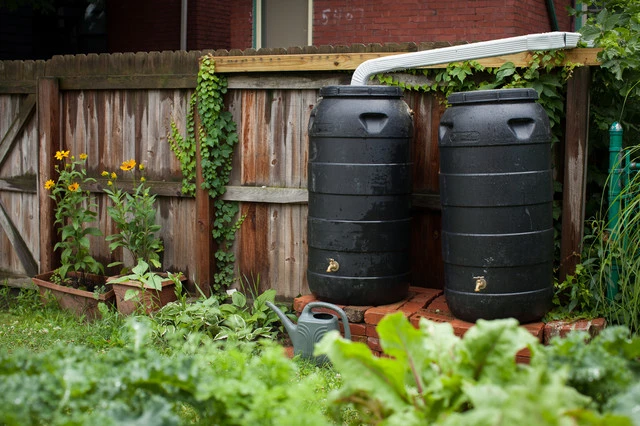Sustainable landscaping isn’t just a buzzword, it’s a way of incorporating sustainable practices and designs into your landscape. So, what does this mean? You may already assume that by having a backyard with all the trees, grass, and dirt you’re already achieving something fairly sustainable right?
Well, with some modern landscape designs, extra fertilizers, water or pesticides can be needed to keep everything looking great. There may also be the requirement for extra materials which aren’t very sustainable. Unfortunately, all these extras can damage your wallet and the environment. So this is where sustainable landscaping comes in. By letting Mother Nature do all the hard work, you’ll be able to sit back and enjoy your great outdoors!
Here are a few ideas to consider if you’re looking to have a sustainable landscape.
Sustainable Landscaping Ideas For 2024
1. Dealing With The Rain
In general, rain is good for the yard. It provides all the plants and grass with the needed water for growth. However, too much rain can hamper this growth by leaching nutrients from the soil. Another big issue with too much rain is the pooling of water and flooding. Thankfully, there are a few ways to deal with this rain sustainably.
Rain Garden
Rain gardens are useful solutions in the landscape – they filter and slow down rainwater pouring off roofs, across lawns, and paving. Rain gardens capture the water temporarily in a basin where it percolates into the ground, recharging depleted groundwater. It also traps residues like fertilizers so that they do not pollute our lakes and streams. But most of all through thoughtful design and plant selection – they are beautiful!
Rain Harvesting Tanks And Systems
Rain collection tanks are great for capturing water from rooftops and storing it for use either for a water feature or irrigation. An example most people are familiar with is a rain barrel capturing water from a single downspout for use in watering a garden. If you want to go a step further, you have the option of using a harvesting system to capture rainwater from multiple downspouts storing it underground for use in small or dramatic water features. It can also be linked to a small pump to provide supplemental irrigation throughout the landscape, creating a sustainable supply of water for landscape beds.
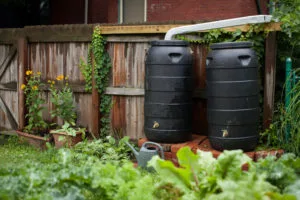
2. Permeable Paving
Permeable paving is a sustainable landscaping option because it allows rainwater to permeate through the surface, reducing the amount of runoff that enters storm sewers and ultimately reducing the risk of flooding.
Some systems can take in rainfall up to 11 inches per hour without shedding on the surface.
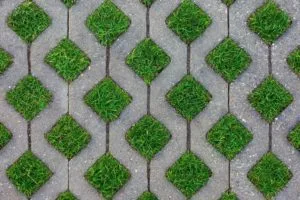
Additionally, permeable paving can help to recharge groundwater aquifers, which is particularly important in areas where water resources are scarce. The porous surface also filters pollutants out of the water, improving the overall quality of the water that enters rivers and streams. Furthermore, it also allows vegetation to grow through the surface, which can help to improve the overall health of the ecosystem in and around the area. Overall, permeable paving is a sustainable option that can provide numerous environmental benefits.
3. Choosing The Right Plants
When creating a sustainable landscape, it is important to choose plants that are well-suited to the local climate and soil conditions. Native plants are often a good choice, as they are already adapted to the local environment and require less water and maintenance than non-native plants. Drought-tolerant plants are also a good option in areas with low rainfall or water restrictions. Additionally, it’s important to consider plants that can provide multiple benefits, such as those that provide food and habitat for wildlife, improve air quality, and reduce erosion. Some good options to consider include:
- Trees such as oak and maple provide shade and habitat for wildlife
- Berries bushes and fruit trees for providing food for wildlife and humans.
- Grasses and wildflowers for improving air quality and reducing erosion
- Succulents and cacti for their drought-tolerance and low maintenance
- Rain gardens or swales can help to capture and filter stormwater runoff.
It’s also important to use plants that are not invasive and do not displace native species.
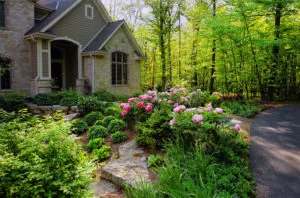
4. Hardscaping With Eco-Friendly Or Local Materials
Part of sustainability is using high-quality local suppliers for products for your landscape. Local means less shipping-related costs to you and our environment. Aside from this, you’ll want to look for materials that are either built to last or if they do break down, they won’t negatively affect the soil or environment
. It is an even better idea to use permeable hardscaping materials! These materials do not need to be just rocks, they can also be the type of concrete you choose for your driveway or walkways. Some of these permeable hardscaping materials include pea gravel, river rock, or porous asphalt.
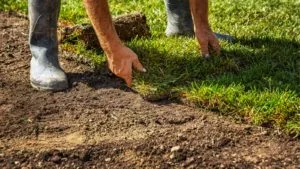
5. LED Lighting
LED lighting provides ambient lighting at a 75 percent reduction in energy use as compared to conventional low voltage, halogen bulbs but with far longer-lasting bulbs and fixtures. The longevity of the bulbs removes the “hassle factor” that people had finding replacement bulbs that were constantly burning out. LED landscape lighting is the ultimate sustainable solution – attractive, and cost-effective with little or no maintenance all while utilizing little energy!
Another great environmental landscaping idea is to incorporate solar-powered lighting into your landscape. Even if we have a few days where it is cloudy, the solar plates will still be able to convert the light into energy for the light fixtures.
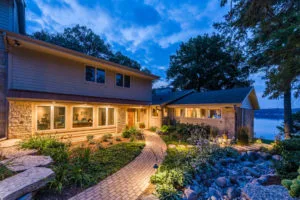
End Card:
These are just some of the ways you can make your landscape more sustainable, but there are always new concepts being developed! If you’re looking at getting any of these solutions installed in your landscape, why not get in touch with Landcrafters Landscaping? We’d be happy to turn your environmentally friendly vision into reality!

